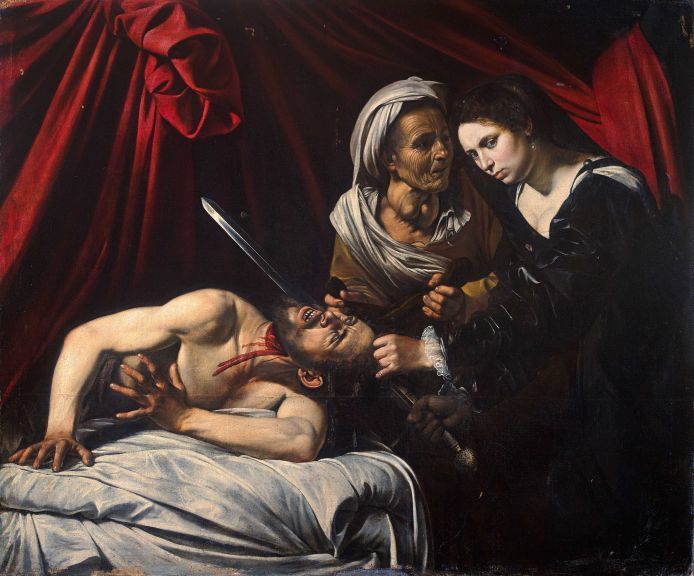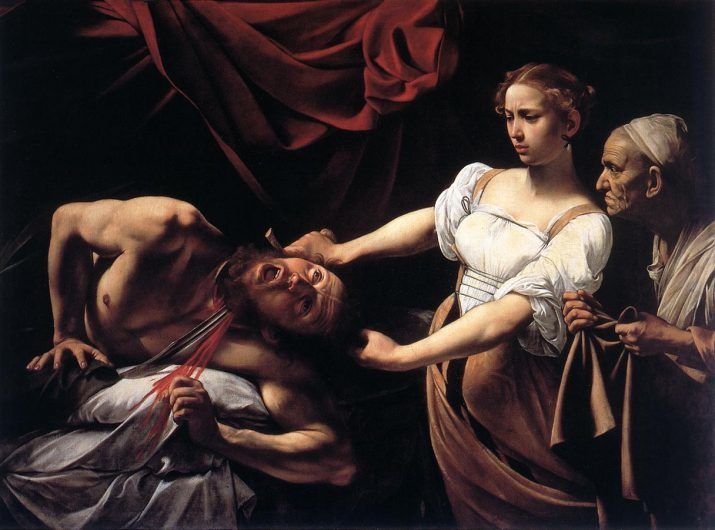
Unknown artist "Toulouse Canvas" - Trajectory of blood spurt is parabolic.
When the owners of a house near Toulouse, France went to fix a leak in the ceiling, they discovered a well-preserved canvas depicting the biblical beheading of General Holofernes by Judith. Experts believe the canvas was painted between 1600 and 1610, and that it could be the work of the Italian master Caravaggio. However, this belief is disputed and is currently being investigated by the Louvre Museum in Paris.
In a study published in European Journal of Internal Medicine, Italian doctor Antonio Perciaccante argues that the newly discovered painting may not be the work of Caravaggio, because of the way in which the blood spurt’s trajectory is painted. We spoke with him about the work.
ResearchGate: What inspired your research into blood spurts and artistic representations?
Antonio Perciaccante: This research started after the recent discovery of a painting of the biblical scene of the beheading of Holofernes by Judith, perhaps by Caravaggio, in Toulouse, France. Together with my wife Alessia Coralli, and coauthors Philippe Charlier and Raffaella Bianucci, we found three additional canvases depicting Holofernes’ beheading: one by Caravaggio, and the others by his followers Louis Finson and Artemisia Gentileschi. We compared the paintings and found differences in the artistic representations of the blood spurts.
RG: What did you find?
Perciaccante: We observed that the trajectory of blood spurts is rectilinear in the canvas by Caravaggio (1599), whereas the unknown artist, Louis Finson (ca. 1607), and Artemisia Gentileschi (ca. 1620) painted a parabolic trajectory. In 1604-1608, Galileo Galilei formulated the “theory of projectile motion,” announcing that when an object or particle is thrown near the earth’s surface, it moves along a curved path under the action of gravity. Therefore, when Caravaggio painted his canvas in 1599, the law of projectile motion had yet to be announced, and the painter could not have known about it. Conversely, Finson and Gentileschi could have been familiar with this theory when they depicted their canvases. This could explain the change in the pictorial representation of blood spurts.

Caravaggio (1599–1602) "Judith Beheading Holofernes" - Trajectory of blood spurt is rectilinear.
RG: What does this mean for the “Toulouse canvas”?
Perciaccante: I think that our observation regarding the blood spurt’s trajectory might provide new scientific insights that can help art experts understand when and who painted the “Toulouse canvas.” Personally, I think that Caravaggio did not paint it.
RG: Where did painters in the 16th and 17th centuries get their biological information? Would they have kept up-to-date with new scientific advancements?
Perciaccante: The vast majority of Renaissance artists were fully aware of the scientific advancements of their time. Young artists learned by oral transmission while practicing in the "botteghe" of the master painters; these were erudite men with a vast knowledge of mechanics, physics, and medicine. Further knowledge was acquired by studying anatomical texts and tables. Anatomical studies, dissection and eye-witnessing public executions helped artists improve their medical knowledge. Caravaggio and his followers were "modern" painters and kept up-to-date with new scientific advancements. One of the principal features of Caravaggio's style was realism, and his focus on reality implies an accurate interest in science, and a knowledge of the laws which govern the physical world.
RG: Do you think, had he known, that Caravaggio would have adjusted his painting in accordance with new science?
Perciaccante: Sure, I think he would have. Caravaggio’s realism originates from a thorough observation of the real world. The painter attended public decapitations and autopsies, where he made observations clearly reflected his masterpieces. Only a direct observation of decapitations and autopsies might explain the veracity of the painted facial expression of Holofernes during his beheading, the strength and the abundance of the blood emerging from his neck. The same can be said of Saint John in “The beheading of Saint John the Baptist,” and the perfect wound in the chest of Jesus in “The incredulity of Saint Thomas.”
RG: Do you know of any Caravaggio paintings that adopt new scientific knowledge?
Perciaccante: If the painting found in Toulouse is attributed to Caravaggio, I think that it could be an interesting case.
For more insights from the scientific community, visit ResearchGate News.
